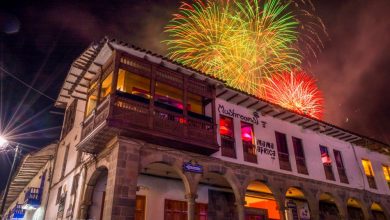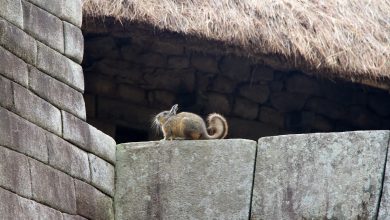New Thought on Q’enqo

Inca Cuzco was grand, like Rome and imperial capital filled with religious and political monuments. While much of Cuzco, again like Rome, is hidden under a modern city, if it is not destroyed, still much remains for those who wish to see it. Unfortunately it does not generally come with the noise, drama, and promotion of a Machu Picchu. Indeed Imperial Cuzco’s role as the capital and most important place in Incadom often seems to shrink in the face of its new role as staging ground for tours to the amazing City on the Saddle.
The City Tour, which most tourists take, does visit a few Inca sites, including the temple complex that include Saqsayhuaman and Q’enqo. Despite the efforts of tour guides to use these site to portray the glories of the Empire and its ways, nonetheless there is much more to them and around them. Recently, Jessica Joyce Christie of East Carolina University published an article in the respected journal Ethnohistory entitled “A New Look at Q’enqo as a Model of Inka Visual Representation, Reproduction, and Spatial Structure” (59:3:597-630, 2012). In her writing she provides an overview of knowledge about the site and a new interpretation of it.
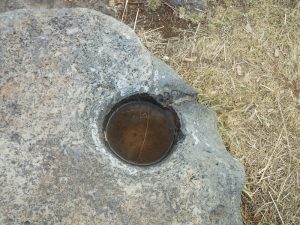
Christie notes that, though tourists focus on the site of Q’enqo a much carved, large rock on top of a cave and altar, the site is more than simply that. It requires viewing in its whole in order for it to be understand. The site, Christy affirms, consists of four separate places that come together as a kind of model of a whole. The four include Q’enqo, which she calls “large Q’enqo”, as well as another site on the other side of the stream nearby called “Lesser Q’enqo (Q’enqo Chico), Qochapata, and the spring Pilcopuquio, and stream that divides the site.
The site was built by the Inca Pachakuti, she writes, and was used to house his mummy and the statue of him called his brother or guauque as well as for the performance of rites pertaining to him.
Q’enqo grande is more than the rock with its different levels, as important as it is.

To the north of the carved outcrop extends a flat area enclosed by a concave, semicircular wall on its northern side (fig. 2). This wall was constructed in fine Imperial Cusco masonry style and contains nineteen niches and one staircase. Valcarcel assumed that the concave wall was originally two meters higher (1935a: 223–33). To the north of the semicircular plaza stands a square structure that incorporates a basin or bath in the inside. This plaza was sealed off by a zigzag wall on the east side and a rectangular structure on the west; however, this left a narrow entrance between the struc- ture and the outcrop (see fig. 1). The focal point of the concave wall and the semicircular plaza is a tall piece of rock on a masonry platform set against the mass of the outcrop. Although modified, this stone was never carved in the geometric style and has been variously interpreted as a phallic ele- ment (Terence Grieder, personal communication, 1982) and as a wak’a in the form of a seated puma, which is the most popular explanation. In any case, the rock was most likely mutilated in colonial times so that its interpretation remains guesswork. The masonry platform was most likely built around the extant boulder, and Van de Guchte argues that the platform walls were intended to be approximately two meters high, since traces of cuts for the accommodation of building blocks can still be seen on the west side of the platform (1990: 144). More traces for the “bedding” of stones are visible on top of the carved outcrop at its northernmost edge. Van de Guchte postulates the presence of another wall, which would have effectively shielded the rock shrine from the eyes of viewers.
Christie argues that the site was a semi-public theatre for the performance of rituals. She sees it as the Patallacta described in the chronicles.
Q’enqo Chico is situated at an altitude lower than that of Q’enqo Grande by twenty-five meters above sea level (fig. 5). The two are separated by the ravine mentioned above and by a distance of approximately forty meters. Like that of Q’enqo Grande, the nucleus of Q’enqo Chico is a mass of limestone; but unlike at Q’enqo Grande, the Inka built a wall around it made of finely cut and irregularly shaped stones. The space between limestone and wall is packed with earth. The entrance to this structure was evidently by means of a staircase on the north side. This staircase was built roughly in the center of the north façade, but it curiously ends about 2.40 meters above present ground level. Perhaps there would have been a wooden ladder leading all the way down
Christie continues to argue that
The formal language of Q’enqo Chico is quite different: the architectural wall of irregularly shaped but precisely fitted stone blocks elevates the carvings quite literally above the human realm, since the access staircase does not continue to the ground. The carving style emphasizes seats with postholes to support canopies; another probable seat with stepped, symmetrically sculpted side panels looks toward the nevado (glaciated, snow-capped mountain) Ausangate (fig. 10). Therefore the formal language indicates that Q’enqo Chico may have been used as an area set aside for the seating of distinguished individuals, although open spaces for an audience are lacking.
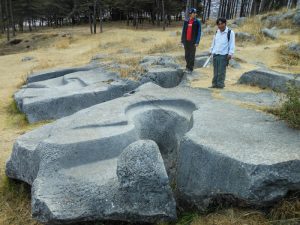
As a result, she claims Lesser Q’enqo was a place for private ceremonies, however one that looked outward and built connections with the landscape, while Q’enqo grande focused on movement to the inside, to the temple in the cave, the world within.
The third area of Q’enqo, Qochapata has a large outcropping of limestone that is still used as a place for offerings. Recent excavations have shown a series of buildings and terraces there. For Christie these are tightly connected to the other two sites and may have been the places where ceremonial artifacts were stored. In sum, Christie sees Q’enqo as an estate a series of temples with residences and so on, rather than simply a few discrete shrines.
The fourth area is the sping Pilcopuquio and the small arroyo in which it runs.
After noting the composite nature of the site of Q’enqo, Christie discusses Inca visual representation. She holds that it is difficult for us, depending of a Western visual culture, of subject-object relations, to make sense of Q’enqo in particular and Inca sites in general. She holds that Inca visual culture developed from three “tiers” that she deduces: 1. a set of Icons (Images that look like that for which they stand, whether specifically or more abstractly), 2) a series of indexes (images that build on a kind of contiguity with that which they represent) whose purpose is the transfer of some kind of nature, energy, or power, and 3) a series of what she calls legisigns following Charles Sanders Peirce.
These latter are abstractions from specific instances and move into a more general space. Of these she talks about the upper and lower difference that was important to the Incas. They divided Cuzco into two halves, the upper and lower, as well as many other areas. Christie notes that these were considered to mark relationship of ancestors – descendants and of the genders.
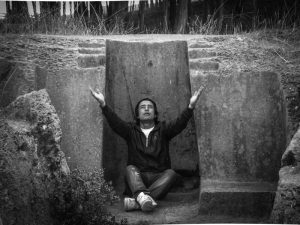
To emphasize this, she notes that the Incas, although capable of very fine, representational art, did not make portraits of their rulers that were representational. Instead they moved them into the abstract space of the legisign, as well as the space of movement from stone to gold, from lower Cusco to upper Cusco.
Christie continues to argue that this movement from the iconic to the legisign is what happens in Inca rock art (shrines). The rock shrines were the more generalized and formalized copies of major ideas that showed the flow of camac, or a generative power and had to be activated through ritual actions. “Ceremonial performances would have focused on fertility-related offerings and the renewal of the cycle between life and death in which ancestors played an active role.” Christie emphasizes that each of these, though general, is in a specific cultural, natural, and historic setting.
In her extended interpretation, Christie is following a group of anthropologists who found the work and distinctions of Charles Sanders Peirce, the American semiotician and philosopher, valuable for making better sense than more traditional symbolic analysis.
In her conclusion Christie states:
it is argued here that Q’enqo Grande and Q’enqo Chico as well as other rock art sites were instantiations of the high-low complementarity and related to Hanan and Hurin, and in these roles, they exemplify vital aspects of Inka practices, or of structuring space as well as visual representation and reproduction as implied by the Quechua word camay. … [They] illustrate an Inka penchant for visually representing and reproducing mental concepts underlying the suyu and Hanan-Hurin divisions and the zeq’e system in multiple material manifestations and at micro-and macroscales.
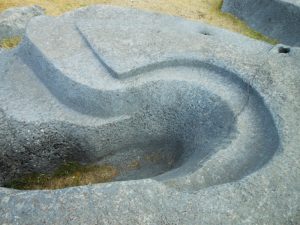
Christie’s work is daunting for people unfamiliar with Perice and Inca studies, but it is useful to work through it to have a better understanding of the many shrines and sites around Cuzco and how an Empire was built through carving notions in the ground elsewhere that were similar to those carved into Cuzco’s landscape.


